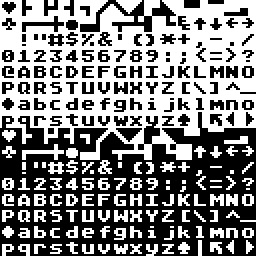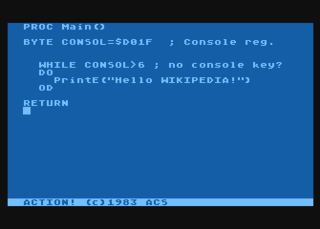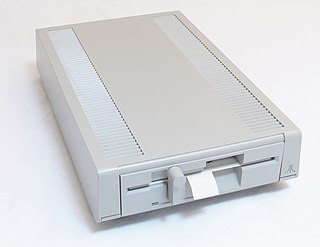
The Atari 8-bit computers, formally launched as the Atari Home Computer System, are a series of 8-bit home computers introduced by Atari, Inc. in 1979 with the Atari 400 and Atari 800. It is the first home computer architecture with coprocessors, enabling more advanced graphics and sound than most of its contemporaries. Video games are key to its software library, and the 1980 first-person space combat simulator Star Raiders is considered the platform's killer app.

Atari BASIC is an interpreter for the BASIC programming language that shipped with Atari 8-bit computers. Unlike most American BASICs of the home computer era, Atari BASIC is not a derivative of Microsoft BASIC and differs in significant ways. It includes keywords for Atari-specific features and lacks support for string arrays.
Microsoft BASIC is the foundation software product of the Microsoft company and evolved into a line of BASIC interpreters and compiler(s) adapted for many different microcomputers. It first appeared in 1975 as Altair BASIC, which was the first version of BASIC published by Microsoft as well as the first high-level programming language available for the Altair 8800 microcomputer.
OS/8 is the primary operating system used on the Digital Equipment Corporation's PDP-8 minicomputer.
The Atari Microsoft BASIC and Atari Microsoft BASIC II variants of the 6502-version of Microsoft BASIC ported to the Atari 8-bit computers. The first version, released 1981, required 32 KB of RAM and was supplied on floppy disk. The second version, released the next year, had most of the code on a ROM cartridge with additional functions on an optional floppy.
BASIC A+ was developed by Optimized Systems Software of Cupertino, California, United States, to provide Atari 8-bit computers with an extended BASIC compatible with the simpler ROM-based Atari BASIC. This interpreter was developed by the same team that developed Atari BASIC. While Atari BASIC came on an 8 KB ROM cartridge, BASIC A+ was delivered on floppy disk and uses 15 KB of the computer's RAM, leaving 23 KB available for user programs in a 48 KB Atari 800. Being an extension of Atari BASIC, BASIC A+ came with a supplement to the former's reference manual as its documentation. In addition to being faster than its ROM-bound counterpart, BASIC A+ provides extra commands for DOS operations, player/missile graphics, and debugging.

The ATASCII character set, from ATARI Standard Code for Information Interchange, alternatively ATARI ASCII, is a character encoding used in the Atari 8-bit home computers. ATASCII is based on ASCII, but is not fully compatible with it.

Action! is a procedural programming language and integrated development environment written by Clinton Parker for the Atari 8-bit computers. The language, which is similar to ALGOL, compiles to high-performance code for the MOS Technology 6502 of the Atari computers. Action! was distributed on ROM cartridge by Optimized Systems Software starting in 1983. It was one of the company's first bank-switched 16 kB "Super Cartridges". The runtime library is stored in the cartridge; to make a standalone application requires the Action! Toolkit which was sold separately by OSS.

Turbo-BASIC XL is an enhanced version of the BASIC programming language for Atari 8-bit computers. It is a compatible superset of the Atari BASIC that shipped with the Atari 8-bit systems. Turbo-Basic XL was developed by Frank Ostrowski and published in the December 1985 issue of German computer magazine Happy Computer. A version for the 400/800 models was released shortly after as Frost Basic 1.4. Several modified versions working with different DOS systems have been released by other authors.

Atari DOS is the disk operating system used with the Atari 8-bit computers. Operating system extensions loaded into memory were required in order for an Atari computer to manage files stored on a disk drive. These extensions to the operating system added the disk handler and other file management features.

DOS XL is a discontinued Disk Operating System (DOS) written by Paul Laughton, Mark Rose, Bill Wilkinson, and Mike Peters and published by Optimized Systems Software (OSS) for the Atari 8-bit computers. It was designed to be compatible with Atari DOS which shipped with Atari, Inc.'s disk drives, which had also been written by the same team.
Shepardson Microsystems, Inc. (SMI) was a small company producing operating systems and programming languages for CP/M, the Atari 8-bit family and Apple II computers. SMI is most noted for the original Apple II disk operating system, Atari BASIC, and Atari's disk operating system. Shepardson Microsystems was founded by Robert Shepardson in Saratoga Springs, New York.
Atari Assembler Editor is a ROM cartridge-based development system released by Atari, Inc. in 1981. It is used to edit, assemble, and debug 6502 programs for Atari 8-bit computers without the need for additional tools. It was programmed by Kathleen O'Brien of Shepardson Microsystems, the company which wrote Atari BASIC, and Assembler Editor shares many design concepts with that language implementation.

The Parallel Bus Interface, or PBI, is a 50-pin port found on some XL models of the Atari 8-bit computers. It provides unbuffered, direct connection to the system bus lines, running at the same speed as the 6502 CPU. The 600XL and 800XL, along with the unreleased 1400XL and 1450XLD have a PBI interface.
Atari Program Exchange (APX) was a division of Atari, Inc. that sold software via mail-order for Atari 8-bit computers from 1981 until 1984. Quarterly APX catalogs were sent to all registered Atari 8-bit owners. APX encouraged any programmer, not just professionals, to submit video games, educational software, applications, and utilities. A few internally developed Atari products were sold through APX, such as Atari Pascal, the developer handbook De Re Atari, and a port of the arcade video game Kangaroo.

Many games, utilities, and educational programs were available for Atari 8-bit computers. Atari, Inc. was primarily the publisher following the launch of the Atari 400/800 in 1979, then increasingly by third parties. Atari also distributed "user written" software through the Atari Program Exchange from 1981 to 1984. After APX folded, many titles were picked up by Antic Software.

SpartaDOS X is a disk operating system for the Atari 8-bit family of computers that closely resembles MS-DOS. It was developed and sold by ICD, Inc. in 1987-1993, and many years later picked up by the third-party community SpartaDOS X Upgrade Project, which still maintains the software.

MAC/65 is a 6502 assembler written by Stephen D. Lawrow for the Atari 8-bit family of home computers. MAC/65 was first released on disk by Optimized Systems Software in 1982, with the program requiring 16 KB RAM. A bank switched "SuperCartridge" from OSS followed in January 1984 for US$99, occupying only 8 KB.

The XF551 is a 5 1/4 inch floppy disk drive produced by Atari, Inc. for the Atari 8-bit computers. Introduced in 1987, it matches the gray design language of the XE models. It was the first drive from the company with official support for double-density and double-sided floppy disks—360 kB of storage per disk—and was also the final floppy disk drive Atari produced for the 8-bit computers. The XF551 allows faster transfer speed when used in double-density mode, doubling performance.











